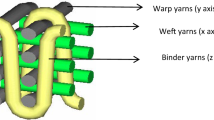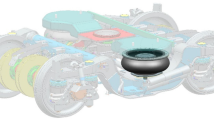Abstract
Using the perforated yielding shear plates as an energy dissipated device instead of lead core in rubber bearing is assessed in this paper. The advantage of this innovative isolator compared to lead rubber bearing is the ability of being replaced easily and its less displacement with high ability of energy dissipation. Three different isolators with perforated shear plates with hole cross-section of 15%, 18%, and 33% of cross-sectional of plate surface area are investigated. Three types of shear plates of 2, 3 and 4 mm thicknesses made of two types of steel with different yield stress are assessed. By decreasing the shear plate thickness and increasing the number of the plate holes and selecting the shear plate with lower yield stress, the effective stiffness and the amount of energy dissipation and lateral force in the isolator are reduced. Changing shear plate thickness and number of holes do not affect the viscous damping, while increasing the plate yield stress increases viscous damping. Therefore the choice of the shear plate with appropriate thickness, number of holes and plate yield stress can lead to an isolator with acceptable behavior. The suggested isolator can achieve similar characteristics of lead rubber bearing at 50% shear strain and therefore its design basics should be defined differently rather than lead rubber bearing.






















Similar content being viewed by others
References
Abe, M., Yoshida, J., & Fujino, Y. (2004). Multiaxial behaviors of laminated rubber bearings and their modeling. I: Experimental study. Journal of Structural Engineering, 130(8), 1119–1132.
Ahn, H. J., Kim, Y. J., & Bae, J. H. (2016). Cyclic loading test of wall damping system with steel dampers. Advances in Structural Engineering, 19(8), 1262–1274.
Asl, M. J., Rahman, M., & Karbakhsh, A. (2014). Numerical analysis of seismic elastomeric isolation bearing in the base-isolated buildings. Open Journal of Earthquake Research, 3(01), 1.
Bhuiyan, A., Okui, Y., Mitamura, H., & Imai, T. (2009). A rheology model of high damping rubber bearings for seismic analysis: Identification of nonlinear viscosity. International Journal of Solids and Structures, 46(7), 1778–1792.
Chan, R. W., Albermani, F., & Kitipornchai, S. (2013). Experimental study of perforated yielding shear panel device for passive energy dissipation. Journal of Constructional Steel Research, 91, 14–25.
Chan, R. W., Albermani, F., & Williams, M. S. (2009). Evaluation of yielding shear panel device for passive energy dissipation. Journal of Constructional Steel Research, 65(2), 260–268.
De Matteis, G., Sarracco, G., & Brando, G. (2016). Experimental tests and optimization rules for steel perforated shear panels. Journal of Constructional Steel Research, 123, 41–52.
Dezfuli, F. H., & Alam, M. S. (2013). Shape memory alloy wire-based smart natural rubber bearing. Smart Materials and Structures, 22(4), 045013.
Dezfuli, F. H., & Alam, M. S. (2015). Hysteresis model of shape memory alloy wire-based laminated rubber bearing under compression and unidirectional shear loadings. Smart Materials and Structures, 24(6), 065022.
Dezfuli, F. H., & Alam, M. S. (2017). Smart lead rubber bearings equipped with ferrous shape memory alloy wires for seismically isolating highway bridges. Journal of Earthquake Engineering, 22, 1–26.
Dezfuli, F. H., Li, S., Alam, M. S., & Wang, J. Q. (2017). Effect of constitutive models on the seismic response of an SMA–LRB isolated highway bridge. Engineering Structures, 148, 113–125.
Formisano, A., Lombardi, L., & Mazzolani, F. (2016). Perforated metal shear panels as bracing devices of seismic-resistant structures. Journal of Constructional Steel Research, 126, 37–49.
Ge, H., Chen, X., & Kang, L. (2012). Demand on stiffened steel shear panel dampers in a rigid-framed bridge pier under repeated seismic ground motions. Advances in Structural Engineering, 15(3), 525–546.
Ghobarah, A., & Ali, H. (1990). Seismic design of base-isolated highway bridges utilizing lead–rubber bearings. Canadian Journal of Civil Engineering, 17(3), 413–422.
Iizuka, M. (2000). A macroscopic model for predicting large-deformation behaviors of laminated rubber bearings. Engineering Structures, 22(4), 323–334.
Naeim, F., & Kelly, J. M. (1999). Design of seismic isolated structures: from theory to practice. Hoboken, NJ: Wiley.
Oh, S. H., Song, S. H., Lee, S. H., & Kim, H. J. (2013). Experimental study of seismic performance of base-isolated frames with U-shaped hysteretic energy-dissipating devices. Engineering Structures, 56, 2014–2027.
Paul, D. (2016). Effect of lead in elastomeric bearings for structures located in seismic region. Procedia Technology, 25, 146–153.
Purba, R., & Bruneau, M. (2009). Finite-element investigation and design recommendations for perforated steel plate shear walls. Journal of Structural Engineering, 135(11), 1367–1376.
Roberts, T. M., & Sabouri-Ghomi, S. (1992). Hysteretic characteristics of unstiffened perforated steel plate shear panels. Thin-Walled Structures, 14(2), 139–151.
Ryan, K. L., Kelly, J. M., & Chopra, A. K. (2005). Nonlinear model for lead-rubber bearings including axial-load effects. Journal of engineering mechanics, 131(12), 1270–1278.
Sanchez, J., Masroor, A., Mosqueda, G., & Ryan, K. (2012). Static and dynamic stability of elastomeric bearings for seismic protection of structures. Journal of Structural Engineering, 139(7), 1149–1159.
Toopchi-Nezhad, H., Tait, M. J., & Drysdale, R. G. (2008). Testing and modeling of square carbon fiber-reinforced elastomeric seismic isolators. Structural Control and Health Monitoring, 15(6), 876–900.
Valizadeh, H., Sheidaii, M., & Showkati, H. (2012). Experimental investigation on cyclic behavior of perforated steel plate shear walls. Journal of Constructional Steel Research, 70, 308–316.
Vian, D., Bruneau, M., Tsai, K. C., & Lin, Y. C. (2009). Special perforated steel plate shear walls with reduced beam section anchor beams. I: Experimental investigation. Journal of Structural Engineering, 135(3), 211–220.
Warn, G. P., & Ryan, K. L. (2012). A review of seismic isolation for buildings: historical development and research needs. Buildings, 2(3), 300–325.
Williams, M. S., & Albermani, F. (2003). Monotonic and cyclic tests on shear Diaphragm dissipators for steel frames. Civil Engineering Research Bulletin No. 23, University of Queensland, Australia.
Author information
Authors and Affiliations
Corresponding author
Rights and permissions
About this article
Cite this article
Saadatnia, M., Tajmir Riahi, H. & Izadinia, M. Hysteretic Behavior of Rubber Bearing with Yielding Shear Devices. Int J Steel Struct 19, 747–759 (2019). https://doi.org/10.1007/s13296-018-0159-y
Received:
Accepted:
Published:
Issue Date:
DOI: https://doi.org/10.1007/s13296-018-0159-y




